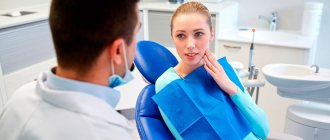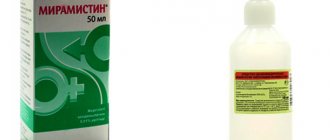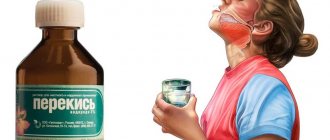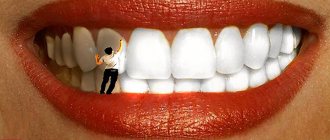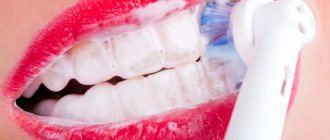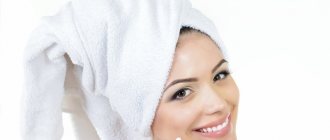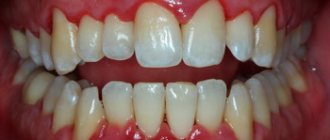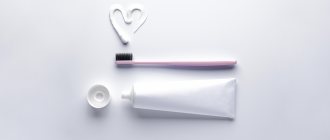12/21/2021
121 740
11 minutes
Co-author, editor and medical expert – Maksimov Alexander Alekseevich.
Hydrogen peroxide was discovered in 1818 by L.Zh.Thenar. Chemical designation H2O2. The substance itself is an almost colorless (pale blue) viscous substance. Hydrogen peroxide without impurities is an unstable substance; it has the ability to decompose to water and oxygen, releasing a large amount of heat. Unlimitedly soluble in water, alcohols and ethers. There is a 31% solution on sale called “Perhydrol”. Due to its oxidizing properties, hydrogen peroxide acts as an antiseptic. For medical use, a 3% H2O22 solution is used.
When peroxide gets on biological substrates (damaged mucous membranes, microbes), active oxygen is released, which destroys cell membranes, thereby providing an antiseptic effect and cleansing the oropharyngeal mucosa from pathogens and cellular detritus. It also has hemostatic properties1.
Up to contents
Is it possible to gargle with peroxide?
Only a doctor can correctly diagnose and prescribe treatment. To effectively get rid of tonsillitis, consult a specialist.
According to the instructions for use, peroxide is used as a treatment for the pharynx in acute tonsillitis, gingivitis, stomatitis and other pathologies. For treating mucous membranes, a 0.25% solution of hydrogen peroxide is acceptable1. When rinsing, microbial contamination in the throat decreases and inflammation decreases. Lubricating the mucous membrane of the tonsils with a cotton swab dipped in a solution is also used, which helps to avoid unwanted effects on the rest of the epithelium. On the other hand, peroxide does not act selectively on tissues, that is, it damages, along with bacteria, unchanged tissues of the body, which can delay recovery. With long-term treatment with peroxide, adverse reactions are possible: burns of the mucous membrane; in case of allergic reactions, bronchospasm and laryngospasm may develop; if accidentally swallowed, it has a toxic effect on the gastrointestinal tract; if it enters the bloodstream, it causes hemolysis of red blood cells. As science moves forward, this method of treatment fades into the background. Safer and more effective drugs are appearing.
Up to contents
Medicinal properties
For inflammation of the tonsils and mucous tissue, adults and children can gargle with peroxide; the product is an excellent antiseptic and quite safe.
It is a clear, odorless liquid with a slight metallic taste; it dissolves easily in water. If the drug is released in tablet form, it is called hydroperite.
It has oxidative and reductive properties, is very effective even for purulent inflammation of the ENT organs, destroys viruses, fungi and bacteria, eliminates redness and soothes tissues. The medicinal properties are as follows:
- Treatment of arthrosis of the knee joint according to Neumyvakin: compresses of hydrogen peroxide and soda
1Disinfection - thanks to this, viruses, bacteria and yeast-like fungi die, which is why it is used in the treatment of the nose, throat, purulent lesions on the skin, cuts and ulcers. 2Oxygen enrichment - treated tissues are more easily saturated with nutrients and oxygen, which affects rapid recovery and healing. Pain also goes away, the healing process accelerates.3 Increased blood circulation - after treatment, blood flows better to the affected area, tissues are restored faster.
4Increasing local immunity - treatment with the product stimulates the body’s own protective functions, increasing the ability of the laryngeal epithelium to independently fight infectious agents. 5Cleansing - when the throat becomes inflamed, the enzyme catalase is formed on the surface of the mucous membrane. The drug comes into contact with it, forming foam, with which particles of pus and dirt, as well as dead tissue, come out of the layers of tissue. Thanks to this action, the mucous membrane heals faster and is cleansed much deeper. Source: nasmorkam.net If the drug is used correctly in the treatment of inflammation of the larynx, after 1-2 days you can notice an improvement in well-being, cleansing of the mucous membrane from purulent-necrotic plaque, and a decrease in temperature.
Particular attention is paid to the product by people who do not want to immediately begin drug treatment for colds and inflammatory diseases, because peroxide is a safe and effective antiseptic.
Indications
Hydrogen peroxide is widely used in medicine: in surgery for the treatment of purulent wounds, for inflammatory diseases of the mucous membranes, pharyngitis, periodontal disease, for bleeding, for disinfecting instruments and deodorizing. Gargling with hydrogen peroxide makes sense when treating bacterial sore throat. But treatment with only one remedy will not be effective. It should be noted that gargling is an integral part of the complex therapy of tonsillitis.
How to treat a throat with gargling? Let's take a closer look at this issue.
| Recipe for a solution with peroxide You should not prepare the solution for future use; it is better to prepare a fresh one each time, since hydrogen peroxide erodes in the air and there will be no effect from such treatment. | To prepare the desired product, we need 1 part 3% hydrogen peroxide and 11 parts water. Water should be used boiled, cooled to a comfortable temperature of 36-37 degrees. |
| Application of the solution If you tilt your head back, the back wall of the pharynx and tonsils, and the root of the tongue will be more effectively cleansed. Remember that you should not swallow peroxide. | 1. Before the procedure, you should clear your mouth of any remaining food. 2. Take a sip, gargle for 10 seconds and spit. The steps are repeated until the solution runs out. 3. At the end of the procedure, be sure to clear the oropharynx of traces of the product with calendula tincture, chamomile tea or plain water. 4. For the next thirty minutes, you should refrain from eating and drinking. |
The duration of sessions is determined by the severity of the condition. Usually it is 4-5 days, with a frequency of 3-4 times a day. Due to oxidation, including healthy tissue, the use of peroxide can lead to increased sore throat and cough.
In addition to it, there are currently other drugs that are superior in their effectiveness. For example, Hexoral ® rinse solution. The drug is widely active against various types of bacteria and fungi of the genus Candida, and Hexoral ® also treats infections caused by Pseudomonas aeruginosa and Proteus. At a concentration of 100 mg/ml, the drug inhibits the growth of most bacterial strains. In addition, the active substance hexethidine has a weak analgesic effect. Hexoral ® solution is convenient and easy to use and has a pleasant taste. It does not need to be diluted. For adults and children over 3 years old, it is enough to gargle with 15 ml of solution 2 times a day3.
Up to contents
Teeth whitening at home with peroxide: caution is necessary!
Having chosen hydrogen peroxide as a home whitening product, you need to be extremely careful when using this substance:
- Do not swallow under any circumstances; if this happens accidentally, consult a doctor immediately.
- This substance should not be used by pregnant women and children under twelve years of age;
- stop the procedure if there is a feeling of discomfort or redness of the mucous membranes is observed;
- It is not recommended to whiten teeth with peroxide for people with deep wounds or mouth ulcers, as well as for those who have recently had their tongue pierced;
- choose exclusively 3% peroxide for whitening, do not use stronger concentrates;
- Those who have intestinal or stomach diseases should also avoid peroxide;
- check the body's reaction to peroxide before starting bleaching (apply the substance to the back of the hand for a while);
- This type of whitening is not recommended for those who have plates or braces in their mouth;
- do not use large amounts of peroxide, so as not to damage the integrity of the enamel;
- do not keep the product in your mouth for more than a few seconds;
- take breaks between whitening courses;
- There is no need to whiten teeth with peroxide for people with caries, increased sensitivity of enamel and bleeding gums;
- Regardless of the chosen method of whitening, after using peroxide, be sure to rinse your mouth thoroughly;
- eat no earlier than half an hour after the procedure.
In order for whitening to be effective and as safe as possible, you should use only fresh peroxide, which is stored in an airtight jar. In addition, you need to understand that hydrogen peroxide will only help if your teeth have darkened as a result of any external factors. If the yellowness of teeth is hereditary or was acquired while taking antibiotics, then peroxide is powerless.
Try ASEPTA PLUS Gentle whitening paste - it effectively fights plaque and deposits, gently whitens, returning teeth to their natural color. The effect is noticeable after the first 2-3 cleanings.
Proportions: how to dilute peroxide
A gargle for adults is prepared according to the following recipe: 1 tablespoon of pharmaceutical hydrogen peroxide (3%) is diluted in 200 milliliters of water.
Note! If, at this concentration, during rinsing you feel an increase in sore throat, rawness or other unpleasant sensations, you should refuse treatment with peroxide, since these symptoms may indicate an individual intolerance to the drug.
After completing the procedure, it is necessary to rinse your mouth to remove any remaining hydrogen peroxide. To do this, you can make a neutralizing solution of salt and soda. In a glass of boiled water at a comfortable temperature, dissolve 0.5 teaspoon of salt and the same amount of soda; brewed chamomile, sage or boiled water are also suitable.
Up to contents
Pros and cons of using hydrogen peroxide to treat teeth and gums
Based on the available reviews and opinions of people who have used hydrogen peroxide solution for mouth rinsing, this product has the following advantages and disadvantages:
| Advantages | Flaws |
| Complex therapeutic effect, noticeable improvement in oral health. | Possible consequences if used incorrectly. |
| The safety of rinsing gums with hydrogen peroxide if the proportions are observed. | Unpleasant taste in the mouth during and after the procedure. |
| Availability in all pharmacies and low price. | Burning in the mouth when rinsing, especially in the presence of wounds. |
People who often rinse their teeth with this product recommend rinsing their mouth with an infusion of herbs with a pleasant smell after the procedure. This helps reduce the feeling of unpleasant taste and prevent the gag reflex. If you feel a burning sensation, you can dilute the solution to a lower concentration.
Hydrogen peroxide is a useful, widely available remedy that helps fight the symptoms of various dental inflammations. Therefore, it is often prescribed in dentistry and otolaryngology.
To dilute peroxide in the correct proportions in each specific case, an individual consultation with a clinic physician or dentist is advisable. After using the product for any purpose, rinse your mouth thoroughly with boiled water.
Rules for gargling with peroxide
To make the procedure comfortable and safe, you must follow simple rules:
- Treatment should be carried out after meals.
- Before the session, you should rinse your mouth with plain water to remove any remaining food.
- For better rinsing, you should take a sip of the solution into your mouth, throw back your head and, for 10 seconds, treat the back wall of the pharynx and tonsils. Then spit out the solution completely.
- When the solution is finished, rinse your mouth with water with salt and soda, a decoction of chamomile or sage, or regular boiled water will also do.
- After finishing the procedure, do not eat or drink for 30 minutes.
Gargling with peroxide can be hazardous to health if the dilution is incorrect. A “stronger” solution damages the mucous membrane and can do more harm than good, while a weaker one does not have a pronounced therapeutic effect.
Up to contents
Rinse during pregnancy
The state of a woman's immune system changes during pregnancy. Although the drug is safe for use by expectant mothers, it is impossible to predict whether an allergic reaction will occur or not. For proper diagnosis and treatment, consult a specialist. The health of your unborn child is in your hands.
To prevent complications and progression of the disease, it is possible to use more gentle means of local treatment of acute tonsillitis. In modern conditions, there are many safe and effective medications. The doctor will choose the drug that best suits you for treatment.
Up to contents
Gargling for children
Small children under 3 years of age are not recommended to use rinsing solutions as a treatment method. At this age, the child will not be able to correctly perform what is required of him, there is a risk of choking or drinking the solution. Until the age of three, it is better to use other dosage forms. In older children, lavage of the oropharynx is used as an element of complex therapy for tonsillitis.
Children are more likely than adults to experience drug intolerance and allergic reactions due to the fact that the immune system is still developing. When rinsing a child, there is always a risk of swallowing the drug. If ingested, peroxide is toxic to the body, and the effectiveness of a solution with a lower concentration is controversial, so peroxide for gargling in children is not recommended. In all cases of tonsillitis in children, consultation and examination by a doctor is necessary. The health of our children is the most important thing!
Up to contents
What to do about bad breath?
Quite often people suffer from bad breath. Many people struggle with this phenomenon. But overcoming the smell can be difficult. After all, disguising it is one thing, but getting rid of it is a completely different matter. In order to get rid of bad breath, you must first discover its cause. Most often, bad breath is caused by microbes that live in the oral cavity. To defeat them, it is not necessary to immediately go to the dentist and undergo complex treatment. Try the tips below.
Gargling for a sore throat
Sore throat (from the Latin angere - squeeze, squeeze) is a common infectious disease, the local manifestations of which are the inflammatory process in the tonsils.
Classification of tonsillitis
1) Primary tonsillitis (ordinary, simple, banal) - acute inflammatory diseases affecting only the lymphatic elements of the pharynx.
2) Secondary (symptomatic) sore throats are divided into 2 types:
— Damage to the tonsils in acute infectious diseases (scarlet fever, diphtheria, infectious mononucleosis, etc.).
— Damage to the tonsils due to blood diseases (agranulocytic tonsillitis, tonsillitis due to leukemia).
3) Specific tonsillitis - for example, Simanovsky-Plaut-Vincent tonsillitis, fungal tonsillitis, HIV-associated, syphilitic tonsillitis4.
Up to 85% of cases of primary tonsillitis are caused by β-hemolytic streptococcus group A. It is dangerous because, with inadequate treatment and in case of severe infection, it can affect the joints, kidneys, heart valves and nervous system. Acute rheumatic fever with the formation of heart defects, glomerulonephritis, and chorea is considered a serious complication. Therefore, it is so important not to self-medicate, but to consult a doctor if you feel unwell. The term “tonsillitis”, as a rule, is applied specifically to such banal tonsillitis.
A solution of peroxide with water for gargling is used for ordinary sore throats, since when it interacts with bacteria, it destroys the wall of the latter, that is, there is an “application point” for the action of peroxide.
More progressive agents for the local treatment of tonsillitis, such as Hexoral ® rinse solution, not only have a pronounced antimicrobial effect, but also a mild analgesic effect. It does not damage the mucous membrane of the oropharynx3.
Up to contents
Hydrogen peroxide in the treatment of caries
The cause of dental caries is the bacteria Streptococcus mutans, which forms dental plaque - a biological bacterial film. These microorganisms feed on sugars that enter the human body along with food, and as a result of their processing they form organic acids. The latter destroy enamel, dentin and other tooth tissues.
Thus, plaque poses a threat to the development of caries. At the same time, biological film is difficult to remove or destroy with modern antimicrobial drugs. Several years ago, a team of scientists conducted research and developed nanoparticles that can destroy the structure of dental biofilm, destroy pathogenic microorganisms and prevent the development of caries.
Nanoparticles consist of iron oxide, polysaccharides and some other substances. When exposed to an acidic environment (and bacteria in dental plaque produce a lot of organic acids), these nanoparticles begin to produce hydrogen peroxide. This compound has a powerful antiseptic effect, destroys pathogenic microorganisms, destroys bacterial dental films, thereby protecting teeth from carious lesions. As part of the study, scientists tested their development on volunteers and came to the conclusion that nano-sized particles effectively destroy tartar and destroy bacteria without causing damage to the enamel or disruption of the microflora in the oral cavity. According to the scientists' findings, the use of nanoparticles with a one percent solution of hydrogen peroxide destroys more than 99% of cariogenic bacteria.
Researchers have suggested adding such particles to toothpastes or mouth rinses, since the use of these products can be an excellent preventive measure for dental caries. The practical application of the development can only be discussed after successful clinical trials. But the antiseptic effect of hydrogen peroxide on cariogenic bacteria is beyond doubt.
